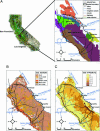Sustainability of irrigated agriculture in the San Joaquin Valley, California
- PMID: 16230610
- PMCID: PMC1257392
- DOI: 10.1073/pnas.0507723102
Sustainability of irrigated agriculture in the San Joaquin Valley, California
Abstract
The sustainability of irrigated agriculture in many arid and semiarid areas of the world is at risk because of a combination of several interrelated factors, including lack of fresh water, lack of drainage, the presence of high water tables, and salinization of soil and groundwater resources. Nowhere in the United States are these issues more apparent than in the San Joaquin Valley of California. A solid understanding of salinization processes at regional spatial and decadal time scales is required to evaluate the sustainability of irrigated agriculture. A hydro-salinity model was developed to integrate subsurface hydrology with reactive salt transport for a 1,400-km(2) study area in the San Joaquin Valley. The model was used to reconstruct historical changes in salt storage by irrigated agriculture over the past 60 years. We show that patterns in soil and groundwater salinity were caused by spatial variations in soil hydrology, the change from local groundwater to snowmelt water as the main irrigation water supply, and by occasional droughts. Gypsum dissolution was a critical component of the regional salt balance. Although results show that the total salt input and output were about equal for the past 20 years, the model also predicts salinization of the deeper aquifers, thereby questioning the sustainability of irrigated agriculture.
Figures




References
-
- Tanji, K. K. & Kielen, N. C. (2002) Irrigation and Drainage Paper 61 (Food and Agriculture Organization, Rome).
-
- Ghassemi, F., Jakeman, A. J. & Nix, H. A. (1995) Salinisation of Land and Water Resources: Human Causes, Extent, Management and Case Studies (Centre for Resource and Environmental Studies, Canberra, Australia).
-
- Tilman, D., Cassman, K. G., Matson, P. A., Naylor, R. & Polasky, S. (2002) Nature 418, 671-677. - PubMed
-
- Maas, E. V. & Grattan, S. R. (1999) in Agricultural Drainage, eds. Skaggs, R. W. & van Schilfgaarde, J. (American Society of Agronomy, Madison, WI), pp. 55-110.
-
- Tanji, K. K. (1990) ASCE Manuals and Reports on Engineering Practices (American Society of Civil Engineers, New York), Vol. 71.
Publication types
MeSH terms
Substances
LinkOut - more resources
Full Text Sources
Miscellaneous

